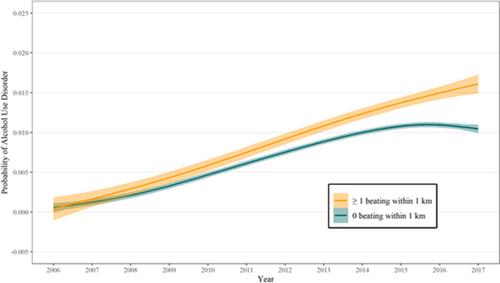Community exposure to armed conflict and subsequent onset of alcohol use disorder
Abstract
Aims
To measure the independent consequences of community-level armed conflict beatings on alcohol use disorders (AUD) among males in Nepal during and after the 2000–2006 conflict.
Design
A population-representative panel study from Nepal, with precise measures of community-level violent events and subsequent individual-level AUD in males. Females were not included because of low AUD prevalence.
Setting
Chitwan, Nepal.
Participants
Four thousand eight hundred seventy-six males from 151 neighborhoods, systematically selected and representative of Western Chitwan. All residents aged 15–59 were eligible (response rate 93%).
Measurements
Measures of beatings in the community during the conflict (2000–2006), including the date and distance away, were gathered through neighborhood reports, geo-location and official resources, then linked to respondents' life histories of AUD (collected in 2016–2018) using the Nepal-specific Composite International Diagnostic Interview with life history calendar. Beatings nearby predict the subsequent onset of AUD during and after the armed conflict. Data were analyzed in 2021–2022.
Findings
Cohort-specific, discrete-time models revealed that within the youngest cohort (born 1992–2001), those living in neighborhoods where armed conflict beatings occurred were more likely to develop AUD compared with those in other neighborhoods (odds ratio = 1.66; 95% confidence interval = 1.02–2.71). In this cohort, a multilevel matching analysis designed to simulate a randomized trial showed the post-conflict incidence of AUD for those living in neighborhoods with any armed conflict beatings was 9.5% compared with 5.3% in the matched sample with no beatings.
Conclusions
Among male children living in Chitwan, Nepal during the 2000–2006 armed conflict, living in a neighborhood where armed conflict beatings occurred is associated with increased odds of developing subsequent alcohol use disorder. This association was independent of personal exposure to beatings and other mental disorders.


 求助内容:
求助内容: 应助结果提醒方式:
应助结果提醒方式:


